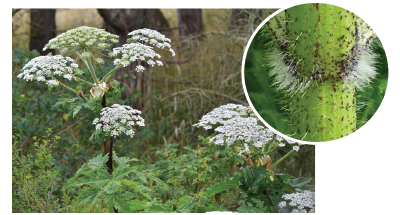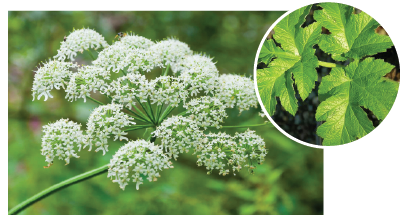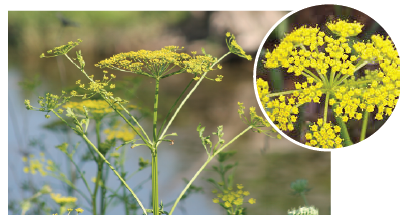Plants to Avoid
Watch out for these plants!
Plants are important to the environment and provide numerous benefits to the habitats where they grow. Unfortunately, some plants can have detrimental effects to the environment and sometimes even human health.
All three of the plants below contain a sap that if touched and exposed to sunlight can cause severe burns and blisters. If you come across these plants on any of our properties, avoid touching them and contact us to make a report. We encourage all visitors to take time to familiarize themselves with these plants and their look-alike species.
Giant Hogweed
Giant hogweed is an invasive plant originating from southwest Asia, and has been identified in several locations in Ontario. It grows best in habitats like old fields and open woodlands, and has been found growing in ditches, streams and along roadsides. This plant spreads quickly and crowds out native plant species, which in turn decreases biodiversity.
Key ID Features
Stem: Green with purple blotches & rigid hairs.
Leaves: Large leaves are spiked with a pronounced jagged appearance, can be 3 feet wide.
Flower: Clusters that appear in late June and July. Looks like Queen Anne’s lace but much larger. Flowers at 6 feet or above so you won’t be able to look at the flower.
Learn more about giant hogweed and its look-alikes here!


Cow Parsnip
Cow parsnip is a perennial native plant that is commonly found in Ontario. Much like giant hogweed, cow parsnip can be found in a wide variety of habitats including grasslands and old fields, it grow best in habitats with moist soil and a lot of shade. Cow parsnip is often confused with giant hogweed, but this plant is native and is usually smaller.
Key ID Features:
Height: 5-8 feet tall
Stem: Deeply ridged stems that may be green or slightly purple with fine, soft, fuzzy hairs.
Leaves: Leaves are 2 – 2.5 feet and covered with soft hairs that may give it a velvety appearance.
Flower: White flower clusters up to 1 foot across.
Wild Parsnip
Key ID Features:
Height: 2 – 5 feet tall.Stem: The stem is light green, with purple blotches and deeply grooved.
Leaves: Compound leaves with a main stem with 5 – 15 leaflets.

What should you do if you find a toxic plant?
Remember to stay on trails and keep your pets on leash to avoid running into poisonous plants like giant hogweed. If you do spot one of these plants, remember:
- DO NOT TOUCH IT.
- REPORT THE SIGHTING to the Invading Species Hotline at 1-800-563-7711. Note that this line is receiving a number of calls about the issue. It may take some time for them to respond to your enquiry. Please be patient.
- CALL A LICENSED PROFESSIONAL, if you want it removed from your private property. Please do not try and do this yourself.
If you find one of these plants at one of our conservation areas, please contact us as soon as possible to report the sighting.
![]() Who to Contact
Who to Contact
Customer Service
✆ 905-895-1281
✆ 1-800-465-0437 Toll free
✉ info@LSRCA.on.ca
 Related Documents
Related Documents
Find out more about Giant Hogweed and what you should do if you find some.
Learn more about invasive species here.
